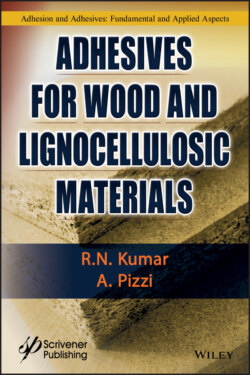Читать книгу Adhesives for Wood and Lignocellulosic Materials - R. N. Kumar - Страница 50
2.3.1.4 Ion–Dipole Interaction
ОглавлениеAn ion-dipole force is an attractive force that results from the electrostatic attraction between an ion and a neutral molecule that has a dipole. It is most commonly found in solutions. It is especially important for solutions of ionic compounds in polar liquids. The potential energy of ion–dipole interaction is given by
where q is the charge on the ion.
One should note that in all the above equations describing the intermolecular attractions, the denominator contains the factor r6. Thus, the types of intermolecular interactions described above occur only at very small distances, of the order of typical atomic bond lengths (the range of non-bonding interactions is between 0.3 and 0.5 nm). For interactions to occur, therefore, the two materials must be able to make intimate contact with each other (i.e., they must be able to approach within a nanometer). This is possible if the adhesive wets the substrate efficiently. The types of interactions and the corresponding energies are given in Table 2.1.
Table 2.1 Bond types and typical bond energies [1].
| Type of interaction | Energy (kJ/mol) | Basis of attraction |
| Bonding | ||
| Ionic | 400–4000 | Cation–anion |
| Covalent | 150–1100 | Nuclei–shared electron pair |
| Metallic | 75–1000 | Cations–delocalized electrons |
| Non-Bonding | ||
| Ion–dipole | 40–600 | Ion charge–dipole charge |
| Hydrogen bonding | 10–40 | Polar bond to hydrogen–dipole charge |
| Dipole–dipole | 5–25 | Dipole charges |
| Ion–induced dipole | 3–15 | Ion charge–polarizable electrons |
| Dipole–induced dipole | 2–10 | Dipole charge–polarizable electrons |
| Dispersion forces | 0.1–40 | Interaction between polarizable electrons |
